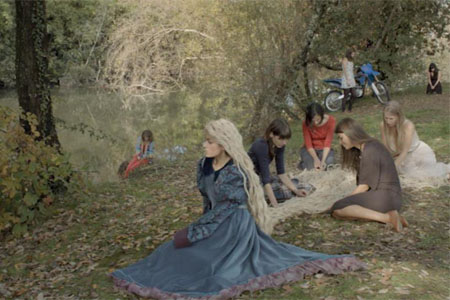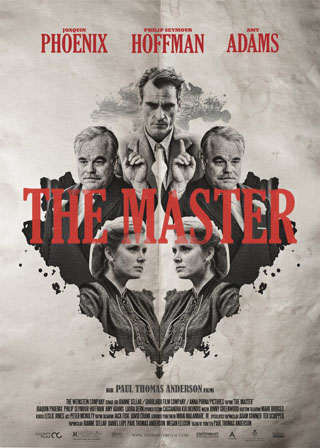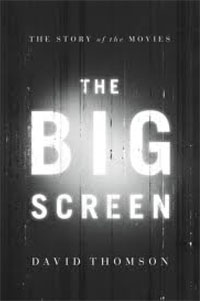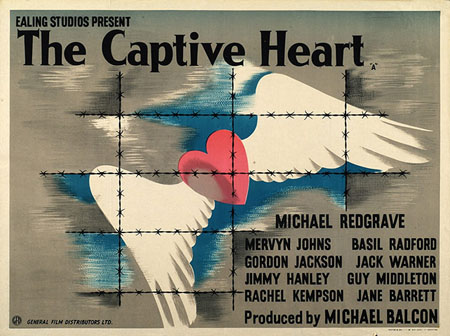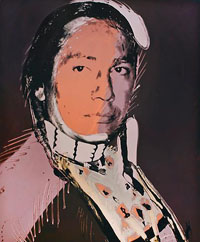You know, this new, freshly completed lineup for the 7th Rome Film Festival that newly appointed artistic director Marco Müller has put together is looking pretty strong. As we noted back in September, the festival will open on November 9 with Centro Histórico, an omnibus film featuring contributions from Aki Kaurismäki, Pedro Costa, Victor Erice, and Manoel de Oliveira. There’ll be short and medium-length works from the likes of Apichatpong Weerasethakul, Lewis Klahr, Michael Almereyda, and Kevin Jerome Everson. And today, as Kevin Jagernauth reports at the Playlist, Müller’s added new films by James Franco, Paul Verhoeven, Peter Greenaway and Mike Figgis.
Listening. Before marrying her precise sound design with imagery in such award-winning films as Day Night Day Night (2006) and The Loneliest Planet (2011), Julia Loktev worked strictly with audio. Film Comment has posted two of her early radio pieces, Voiceage (1990) and Eating in Tongues (1991), introduced by Loktev herself.
Reading. Also at FC: Sarah Mankoff on Pierre Etaix (with eleven clips!), Fernando F. Croce on To Save and Project, MoMA’s 10th International Festival of Film Preservation, and Genevieve Yue on Views from the Avant-Garde at the New York Film Festival. Not only does she have more on this year’s program at Reverse Shot, she also interviews Tony Conrad for FC.
David Ehrenstein, who has a book on Roman Polanski coming out soon, in the Los Angeles Review of Books on Warren Sonbert: “[H]e was our compere—our guide to a world of exquisitely casual chic in such films as Where Did Our Love Go (1966), The Tenth Legion (1967) and The Bad and the Beautiful (1968). Shot with alarming simplicity these narrative-resistant works told no tales, nor were they entries in a cinematic ‘diary.’ Rather they explored a world of ‘figuration’—exquisite urbanites at work (museums, offices) and play (dancing, party-giving and -going). These celluloid ideals were directly connected to ‘real life,’ as Warren would premiere them at the Bleecker on Sunday mornings with the featured participants and their friends present—on- and off-screen space became one.”
Also in the LARoB: Jacob Mikanowski on Paul Thomas Anderson’s The Master, “as wide-open and complex a masterpiece, and as ambiguous and puzzling a film as has appeared in America since David Lynch’s Mulholland Drive or Todd Haynes’s Safe.” He’s not the only one still thinking about this film, either. Idiom has just posted two essays on The Master, one by Trevor Link, who argues that the film is “nearly impossible to understand without some working knowledge of charisma,” and the other by Joseph Jon Lanthier, who focuses on the “inter-institutional dispute” between psychoanalysis and Scientology. And Film International has just posted Jacob Mertens‘s review, and the Morning News is hosting a roundtable discussion. Meantime, Elvis Mitchell keeps both hands on the wheel throughout his conversation with Joaquin Phoenix for Interview.
“True Stories [1986] arrived in cinemas around the same time as other American films quickly identified by critics as postmodern, notably David Lynch’s Blue Velvet and Jonathan Demme’s Something Wild,” writes Rick Poyner at Design Observer. “[David] Byrne’s three-year project, his only full-length feature to date, was unique, though, in making the postmodern culture of the mid-1980s, including the visual environment, its subject.”
“Who is the greatest artist of our time?” asks Camille Paglia, launching her case, arguing in the Chronicle of Higher Education, for… George Lucas.
At Movie Morlocks, Richard Harland Smith looks back on some of the best Halloween scenes in non-Halloween movies. On a related note, Matt Singer‘s latest Criticwire survey question is: “You’ve been hired by your local movie theater to guest curate a Halloween double feature. What two movies do you pick and why?” At the Awl, Anne Helen Petersen presents an “incomplete survey of actual and arguable monsters, broadly defined, from Classic Hollywood.” And at Flavorwire, Alison Nastasi posts “10 Classic Halloween Cartoons.”
Books. For the Financial Times, Peter Aspden reviews J. Hoberman‘s Film After Film, David Denby’s Do the Movies Have a Future?, and David Thomson’s The Big Screen, an excerpt of which—on Spielberg—is running at Thompson on Hollywood.
In the Washington Post, Lloyd Rose finds that in The Redgraves, Donald Spoto “has taken on too much—10 actors spanning four generations.”
DVD/Blu-ray. “John Schlesinger was on a roll when he started filming Sunday Bloody Sunday in 1970. It was one of those rare times when a major film studio—United Artists, in this case—allowed him to make pretty much anything he wanted, even a sophisticated and very personal British movie about an openly gay Jewish doctor sharing his lover with a woman.” Ian Buruma for Criterion on his uncle’s film: “John, to me, was both a figure of glamor, proudly introducing his nephews and nieces to movie stars, who politely feigned an interest, and an indulgent uncle who cared deeply about his family. There is, in fact, a great deal of John in Daniel Hirsh, the gay doctor in the film, played beautifully by Peter Finch.”
New York. With the Museum of the Moving Image‘s retrospective of the work of 28-year-old Filipino filmmaker Raya Martin on through Saturday, Steve Macfarlane writes in the L that he’s “demolished and rebuilt himself with each go, forgoing easy referential/reverential technique-shifts in a body of work that spans eight features over six years. A self-described ‘frustrated experimental filmmaker,’ Martin clearly wants to break free of path dependencies in how cultures tell their own stories: his 2005 feature A Short Film About The Indio Nacional (or, The Prolonged Sorrow of the Filipinos) is actually filmed as if in 1898, when Spain granted independence to the Philippines while simultaneously selling them to the United States. A Short Film is a series of fragments worked out by the director and the Barasoain Kalinangan Theater Group, silent sequences bookended by explanatory title cards and overlaid with tinny music.”
Phil Coldiron for Moving Image Source: “In the opaque historical drama Autohystoria the murder of two Filipino rebels is refigured as an experience in duration and looking, attentiveness to urban spaces linked to attentiveness to history. Independencia recreates another lost period, the early, artificial talking adventure film, exploring the process of combining popular filmmaking with revolutionary messages. In these films—and in Buenos Noches, España‘s infinite, recursive loop of love in space and out of time—there is a commitment to exploring something fundamentally impossible to fully know without betraying that impossibility in the slightest…. How can cinema be dying, or dead, when one of the great directors in the world hasn’t even hit 30 yet?”
Adults in the Dark: Avant-Garde Animation is on at the Museum of Arts and Design, and Heather Hendershot has an overview in Artforum.
“Is photography a way of documenting the world that has an inherent ‘truth-claim’ on the real?” asks J. Hoberman, writing for the New York Review of Books. “Or is it, as [Edward] Steichen suggested, essentially graphic, a technique for creating a certain kind of image? Faking It: Manipulated Photography Before Photoshop, an exhibition now up at the Metropolitan Museum of Art (later traveling to the National Gallery and Houston’s Museum of Fine Art), makes a vigorous case for understanding the medium as Steichen did.” More from John Yau at Hyperallergic.
San Franciso. A preview from Michael Hawley: “The San Francisco Film Society (SFFS) reaches the mid-point of its 2012 Fall Season Wednesday night with their fifth annual French Cinema Now series. The line-up for this year’s seven day, 10-film celebration could be summarized thusly: three crowd-pleasers, five feature directorial debuts and two new works from a pair of arthouse notables.”
London. The BFI’s two-month retrospective Ealing: Light and Dark is on through December 30, and the Guardian‘s collected posters and artwork.
For the Telegraph, Sheryl Garratt spends more than a little time with Deborah Nadoolman Landis, co-curator of the V&A’s autumn exhibition, Hollywood Costume, on through January 27: “the point she emphasizes when we first meet in London and many more times during our subsequent trip to meet some of the costume designers in Los Angeles… is that it is not about the clothes. Good costume design is about creating characters.”
Nominations. The International Documentary Association has announced that, along with five shorts, the “five films nominated in IDA’s Best Feature category include The Central Park Five (Ken Burns, Sarah Burns and David McMahon), The Invisible War (Kirby Dick), The Queen of Versailles (Lauren Greenfield), Searching for Sugar Man (Malik Bendjelloul), and Women With Cows (Peter Gerdehag).”
And the European Film Academy has announced that its nominated three docs for European Film Awards: Manuel Stürler’s Hiver Nomade (Winter Nomads), Julien Temple’s London: The Modern Babylon, and Jérôme le Maire’s Thé ou électricité (Tea or Electricity).
Obits. “Russell Means, who gained international notoriety as one of the leaders of the 71-day armed occupation of Wounded Knee in South Dakota in 1973 and continued to be an outspoken champion of American Indian rights after launching a career as an actor in films and television in the 1990s, has died,” reports Dennis McLellan in the Los Angeles Times. Means was 72. His “acting career began after he was approached by a casting director to play Chingachgook in the 1992 movie The Last of the Mohicans. A string of more than 30 other roles in films and television followed, including playing a shaman in Natural Born Killers and providing the voice of the title character’s father in Pocahontas. Means’s transition from activist to actor was deemed a natural one.”
Two updates. First, also in the LAT, Andrew Blankstein and Richard Winton report that “Tony Scott was not suffering from cancer and did not have any serious underlying medical conditions at the time of his suicide.” And in the Guardian, Ronald Bergan remembers Argentinian director and screenwriter Eduardo de Gregorio, who passed away ten days ago, aged 70. He “brought [a] Borgesian aura to bear on the five features he directed, and on the screenplays he wrote with Jacques Rivette and Bernardo Bertolucci.”
Viewing. Catherine Grant presents “Rollin’, Rollin’, Rollin’! Video Studies of the Western.”
More browsing? Check in with the Film Doctor.
For news and tips throughout the day every day, follow @KeyframeDaily on Twitter and/or the RSS feed. Get Keyframe Daily in your inbox by signing in at fandor.com/daily.

